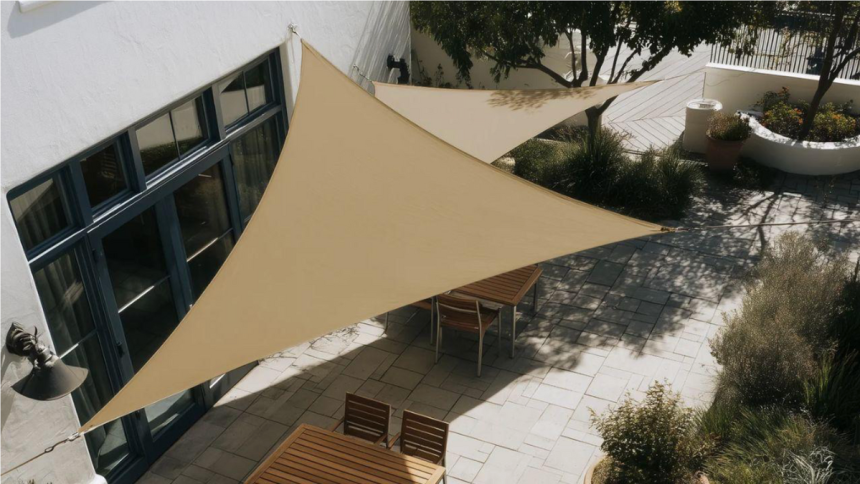The beach shade sail has emerged as a common and convenient choice to enrich the outdoor spaces with comfort and style. They offer a nice architectural flair in addition to the much-needed UV protection that they bring to patios, decks, gardens, and even commercial environs. The shapes of a triangle and a rectangle are two of the most frequently selected shapes among the numerous shapes provided. Each of them possesses special advantages, and the most suitable one is typically related to the purpose it is going to be used for, the size of the area, and the style it will have. Such understanding concerning the differences between these two shapes can help consumers make a much more precise judgment concerning their outdoor setup.
Getting to Know the Basics of Shade Sails
Shade sails refer to stretchable fabric coverings, which provide shade and aesthetic attributes. They usually consist of long-lasting substances such as high-density polyethylene (HDPE) or waterproof polyester and are built in such a way that they help prevent harmful UV rays but also allow airflow beneath. With the assistance of tension anchor points, they are outfitted on posts, walls, or already established structures. They also come in different shapes and sizes, and it is important that one chooses the finest to satisfy the functional needs as well as the aesthetic needs of the place.
Triangle Shade Sails
Triangle shade sails have a slender, elegant look. They have three anchor points, which give it a clean and minimalistic look that suits modern outdoor designs. Their shape inherently makes a twist or a slope that gives the fabric a dynamic shadow and interest in the flow of time. This aesthetic value makes the triangle sails common in confined areas or where there is a greater concern for creativity.
The disadvantage of triangle sails, though, is that they theoretically cover less area than a rectangular sail of the same size and, therefore, tend to be most effective in areas of close quarters or when overlapped by other sails. These sharp features and open angles also allow light and wind circulation into them, and this can be beneficial or disastrous depending on the climate and the time of the year. Triangle sails are breezier and less enclosed in windy or hot surroundings.
Rectangular-Shaped Sail Shade
Shade sails are however, are rectangular or square and provide more even coverage. They are also designed with four anchor points to cover bigger areas, so they are good to use in patios, dining areas, or poolside lounge areas. Such sails are likely to give a greater shade and shield against the sun’s rays, especially when they are mounted at a given angle to enable the rainwater water trickle away.
The form of rectangular sails is more often conformable to the geometry of houses, fences, or gardens. They are also symmetrical, which can be handy to make a shady pathway or convert outdoor furniture. To those families seeking the most sun protection during the hottest hours of summer, a properly placed rectangular sail may be the answer to harsh sun.
Space and Layout Considerations
The space should also be well planned before choosing the shape of the shade sail (triangle or rectangle). Company thehues triangle sails will mostly be used in smaller and more intimate environments or to fill some space between larger constructs. They may alternatively be stacked in visually striking combinations, with several sail triangles overlapping each other.
In larger spaces, rectangular sails tend to be more effective. They can also cover wide areas in a very efficient manner without the necessity of numerous installations. Being mounted at various heights or angles, the rectangular sails may also provide a more dynamic look in addition to being more functional.
Wind and Weather Matters
One more thing that should be considered is the meteorological situation in the region. The form of the sail is also very important in the performance of the structure in places where there is high velocity of wind or frequent storms. In some configurations, the triangle sails, with fewer anchor points and a more streamlined profile, can be better in relation to wind. They have less surface area, which lowers wind load and minimizes possible fabric-sagging or anchor-point stress.
Rectangle sails provide more coverage at the price of wind uplift potential unless they are fastened securely and are appropriately tensed. In this scenario, they can be vertically installed at a slant to permit the wind and rain to spill over them instead of building. Strength in the edges and sturdy hardware is also necessary to last longer in bad weather.

Style Preferences and Aesthetic Goals
In addition to technical issues, the aesthetic impact of the shade sail is a relevant factor in outdoor design. Triangle sails can be subjected to artistic and modern designs. They can make an outdoor room of a backyard or garden with their sharp edges and asymmetrical shapes. Combined in layers or together with other figures, they offer dynamic forms that come into life in the flow of the sun.
By comparison, however, rectangle sails have a more traditional and formal look. They are symmetrical and hence fit in line with pergolas, fences, and rectangular patios. They help to achieve a consistent and organized design language, which most homeowners and businesses like to use, especially when they are repeated or even stacked parallel to each other.
Customization and Installation Advice
Triangle and rectangle shade sails may be designed to suit the individual shapes of a space. As an example, TheHues provides custom fitting choices in both waterproof and breathable materials and UVShield technology as additional protection. It will be made of a different color, finishing, as well as mounting hardware that is chosen by the shopper so that he/she can make it fit his/her requirements.
The anchor points should be very strong and capable of supporting the tension of the sail during installation. The installation is also suggested to be slightly slanting in order to encourage the runoff of water, particularly the waterproof versions. Ensuring that the sails are neither over- nor undersized during proper tensioning can increase performance, as well as the life of the sail.
Conclusion
Conclusively, there is no standard answer in the triangle and rectangle shade sails. They both have their advantages, which suit various requirements and areas. Homeowners and designers can make well-informed choices. It is done by evaluating various factors. TheHues can offer well-designed and sophisticated solutions, combining the sense of beauty, strength, and usability. An appropriate shape makes every outdoor area a trendy place where people can rest, feel safe, and find the reflection of modern taste.
Lynn Martelli is an editor at Readability. She received her MFA in Creative Writing from Antioch University and has worked as an editor for over 10 years. Lynn has edited a wide variety of books, including fiction, non-fiction, memoirs, and more. In her free time, Lynn enjoys reading, writing, and spending time with her family and friends.















